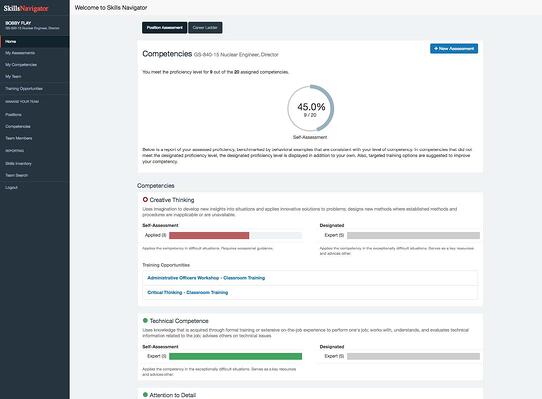Talent Management goes beyond the day to day tasks of managing human capital and focuses on how best to support your employees from hire-to-retire – from on-boarding the right people, to assessing and guiding them in skill development, and to preparing them for new positions in the agency.
That is why EconSys developed SkillsNavigator as an integral part of our Workforce Analytics suite of tools for federal talent management. Designed to provide high-value competency assessments for managers and employees, SkillsNavigator helps identity and manage competency gaps in federal agencies.
The Role of Skills Assessment for Talent Management
Effective talent management requires a keen understanding of the needs of your organization, the skills of your current workforce, and the gaps that need to be filled. It’s about strategic training for your employees to ensure they are ready for the next step in their career development and any shifts in job requirements as the role evolves.

>>> Download the eBook on Building and Executing Competency Models for Federal HR.
That’s where skills assessment comes in. Your organization will develop a competency model based on observations of your workforce, subject-matter expert (SME) interviews with people who have been on staff for several years, focus groups with key staff members, and insights from key decision makers and executives. The goal of this process is to build a model that clearly identifies the skills needed in your agency for:
That is why EconSys developed SkillsNavigator as an integral part of our Workforce Analytics suite of tools for federal talent management. Designed to provide high-value competency assessments for managers and employees, SkillsNavigator helps identity and manage competency gaps in federal agencies.
The Role of Skills Assessment for Talent Management
Effective talent management requires a keen understanding of the needs of your organization, the skills of your current workforce, and the gaps that need to be filled. It’s about strategic training for your employees to ensure they are ready for the next step in their career development and any shifts in job requirements as the role evolves.
>>> Download the eBook on Building and Executing Competency Models for Federal HR.
That’s where skills assessment comes in. Your organization will develop a competency model based on observations of your workforce, subject-matter expert (SME) interviews with people who have been on staff for several years, focus groups with key staff members, and insights from key decision makers and executives. The goal of this process is to build a model that clearly identifies the skills needed in your agency for:
- Current job requirements, including areas that have substantial gaps between current and needed skill levels;
- Future job requirements based on workforce gap analysis performed for the next three-to-five years; and
- Career development paths and the skills your best employees will need when moving into higher-grade positions.
A competency model helps to identify the specific skills that a new manager, information technology professional, or human resources specialist needs to have when entering the job, and then chart a path for their future skills needs.
Building a Training and Development Plan through Skills Assessment
By creating a competency model to match the skills needs of your organization, you can vastly improve the quality and relevance of your training and development plans. Moving away from purely administrative approaches to training, it is important that individuals adhere to custom development plans based on skill gaps in their current position, not a blanket training requirement.
You can now map out the desired skills and proficiencies in high-value skills for each of your employees based on position, grade level, and future career path. This allows you to provide targeted training plans that address only the most glaring gaps in their proficiencies. Someone who is a natural communicator doesn’t necessarily need additional beginner-level training in how to hold one-on-one meetings.
Using SkillsNavigator to Support Talent Management Efforts in Federal Agencies
In using SkillsNavigator to support your talent management efforts, you can assess your workforce more effectively within a competency model built for your agency. You can then identify skills gaps, build relevant training programs, and build a more agile, better equipped workforce to address both current and future needs.
Learn more about how SkillsNavigator supports talent management efforts in skills development or download our brochure to see what it offers.

